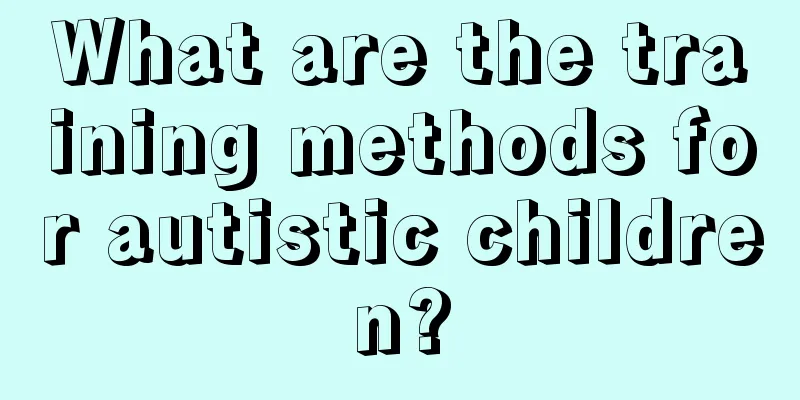What are the training methods for autistic children?

|
The probability of children suffering from autism is very high, and parents are the most worried after their children suffer from autism. Many parents cannot bear their children's autism. They don't like to make friends, communicate with others, or care about others. They are always emotionally indifferent. After a child's autism occurs, it has a great impact on the child's learning. The occurrence of autism makes the child's life lose its color. So how should we train children with autism? Commonly used methods of fine motor training in the rehabilitation training of autistic children Fine motor skills refer to the movements of the hands and fingers, including grasping, pinching and some simple techniques. Due to delayed brain development or brain damage, autistic children have poor development of fine motor skills, insufficient hand strength, coordination and dexterity, and poor hand-eye coordination, which affects the development of their living abilities. Fine motor training can enrich their perception and cognition of the attributes of things, thereby improving their thinking level. We need to create conditions for autistic children to carry out fine motor training at different stages of their growth and development, and master actions such as grasping, holding, patting, hitting, knocking, knocking, digging, writing and drawing, cultivate hand flexibility and accuracy, improve hand-eye coordination, and lay a solid foundation for the development of thinking ability. According to the actual development situation of autistic children and the characteristics of autistic children, the senior rehabilitation instructor of Zhengzhou Kangda Ability Training Center divides the fine motor training of autistic children into the following parts: Early fine motor training for autistic children under 2 or 3 years old 1. Training by dropping objects into containers Teach autistic children to put small objects into containers accurately. The small objects and windows used should preferably be made of metal, which are not easy to break but will make noises. The pleasant sound of the metal being struck will arouse their interest, and autistic children will continue to do it without getting tired of it. The objects used should be changed according to the situation of the autistic children, from large to small. For example, instead of putting small locks and small cars in cans, we now put raisins, rice, etc. in small bottles and bowls. Parents can also play the "ring toss" game with their children, and encourage whoever can do it correctly. The throwing process not only trains the flexibility of finger movements, but also exercises the hand-eye coordination. 2. Bead threading training Teach autistic children to play games such as threading beads and buttons using iron wire or thicker covered electrical wire. The autism rehabilitation instructor or parents should teach them how to put on the clothes, and the autistic children will start by imitating the autism rehabilitation instructor, get help from their parents, and then pick up the buttons, beads and threads and do it themselves. It can exercise the flexibility of hand coordination and hand-eye coordination of autistic children. 3. Flip-open training Autism rehabilitation instructors or autistic parents look at picture books or photo albums with their autistic children, and encourage the autistic children to turn the pages with their hands. Looking at the people and objects in the picture album is not the ultimate goal. The purpose is to exercise the finger and wrist strength of autistic children in the process of turning the pages. Therefore, no matter whether the autistic child reads the pictures or not, as long as the autistic child can keep turning the pages, it doesn't matter even if he turns several pages at a time. As the flexibility of his fingers increases, he will gradually be able to turn the pages one by one from thick to thin. 4. Tearing and rubbing training For example, if you take some used paper, outdated books, paintings, etc. and let autistic children tear them, you should encourage them to tear them boldly, and the more broken the pieces, the better, because the smaller the pieces, the higher the finger skills required for autistic children, which means the pinching force between their thumbs and index fingers is stronger. Parents can also take some harder paper or scraps of cloth and ask autistic children to rub or roll them, which can not only exercise the flexibility of their fingers, but also exercise the wrist strength of autistic children. When parents are washing clothes, they can also let their babies and young children learn to scrub the clothes with their hands, which can also help train their finger skills. 5. Holding training Autistic parents or autism therapists put some small objects such as beans, stones, peanuts, etc. in a box and let the autistic children use tweezers or chopsticks to pick them out and put them on the ground. After picking up the pieces, put them back into the box, and repeat this process. During this process, the objects being squeezed out should also change from large to small, and from few to many. At the same time, parents should try their best to train autistic children to use chopsticks to pick up their own food. All of the above training methods can help children improve autism. When improving a child's autism, you must insist on using these exercises to slowly improve the child. You must persist and be patient. Don't give up when you feel that you can't get results. You should also communicate more with your child to make your child's life more interesting. Let your child contact more children. This will improve the child's mood and improve the symptoms of the disease. |
<<: What should I do if my child has a bacterial infection and fever?
>>: What is the most nutritious food for babies?
Recommend
What causes zinc deficiency in children?
Children are the treasures of the family. They ar...
What complementary food should babies eat when they have a cold?
Baby colds are a common pediatric disease. The oc...
What is the treatment for neonatal jaundice?
Neonatal jaundice values are a problem that man...
How to quickly relieve the pain of tooth decay in children? Do you know these methods?
Once tooth decay causes pain, it is really hard t...
How old can a girl grow taller?
Some girls are shorter because of their short par...
Can newborns drink milk powder?
I believe many people know that after a newborn i...
Treatment for yellow urine in newborns
We may know that there are many reasons for the y...
Baby diarrhea diet therapy
1. Steamed applesauce: Steamed apples have a good...
What preparations should be made for teething in six-month-old babies?
The birth of every baby is a surprise to a family...
Can children eat black chicken?
Children can eat black chicken, mainly because bl...
Is it normal for a four-year-old to start losing teeth?
Most children start to change their teeth when th...
What are the methods of making pig liver porridge for baby food
Babies should be given appropriate complementary ...
What are the dangers of picky eating in babies? Are there any ways to solve it?
I believe everyone is familiar with the term &quo...
What causes purpura in children?
Children are in the best period of development, b...
What to do if your teething baby has a fever
For babies, their immunity is too low and their r...









